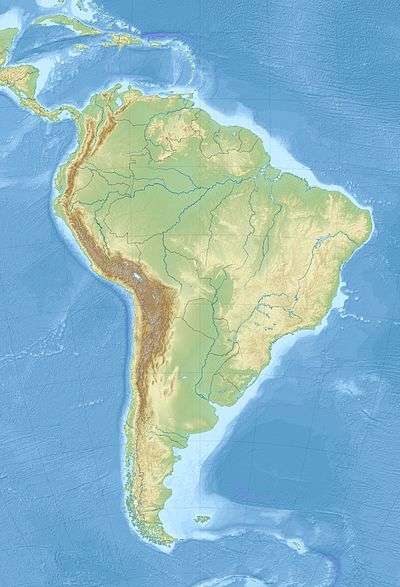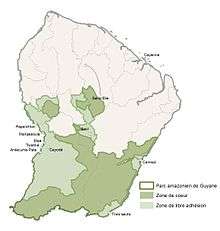Guiana Amazonian Park
Guiana Amazonian Park (French: Parc amazonien de Guyane) is the largest National Park of France, aiming at protecting part of the Amazonian forest located in French Guiana which covers 41% of the region. It is the largest park in France, in the European Union,[2] and one of the largest national parks in the world.
| Parc amazonien de Guyane | |
|---|---|
| Guiana Amazonian Park | |
IUCN category II (national park) | |
 | |
 | |
| Coordinates | 2°50′18″N 53°46′20″W |
| Area | 20,300 km2 (7,838 sq mi) |
| Established | 27 February 2007 |
| Governing body | Parcs nationaux de France[1] |
| web | |
It cannot be accessed from the sea-shore or by any other means other than by airplane or pirogue.
The protected area covers some 20,300 square kilometres (7,840 sq mi) for the central area (where full protection is enforced) and 13,600 square kilometres (5,250 sq mi) for the secondary area. Thus, the overall protected area represents some 33,900 square kilometres (13,090 sq mi) of rain forest.[3]
The park has been built upon territories belonging to the communes of Camopi, Maripasoula, Papaïchton, Saint-Élie and Saül.
History
In the framework of the Earth summit in Rio de Janeiro in 1992, the project of a national park in French Guiana was initiated on June 4, 1992, with the impetus provided by François Mitterrand. This was formalised through a draft agreement signed by the presidents of the general council and of the regional council of French Guiana, and also by the French Ministers of the Environment, of the Overseas Departments and Territories and of Agriculture and Forestry. Following this, in 1993 the Mission for the Creation of the French Guiana National Park was created.
A first project was proposed in late 1995 but was finally rejected in December 1997.
On June 21, 1998, the Twenké agreement led to the recognition of the rights of the native Amerindians and of the Businengue (Maroons) living within the future park's boundaries.
The final project was presented in early 2006. On March 6, 2006, the decree relating to the project of the national park being taken into account was published in the Official Journal of the French Republic.[4] Within it, the national park's name was switched to Guiana Amazonian Park.
The creation of the park was made effective by decree on February 28, 2007, despite the reluctance of several protagonists involved (general council and regional council of French Guiana). The park's governing body met for the first time on June 7, 2007.[5]
Extent

Within the 20,300 square kilometres (7,840 sq mi) central area, maximal protection is enforced and gold mining is strictly forbidden. However, the lands of the Aluku, Wayana, Wayampi and Teko tribes in Camopi, Maripasoula and Papaïchton do not belong to this core area. The Teko considered it a restriction of their free movement,[6] and the Aluku objected to restrictions to their sacred areas.[7] The restriction of all previously acquired rights of the tribal inhabitants, resulted the exception of the inhabited tribal zone.[8]
Put together with Tumucumaque National Park (covering some 38,800 square kilometres (14,980 sq mi) in neighbouring Brazil), the Guiana Amazonian Park represents the biggest rain forest protected area in the world.
External links
- (in French) Official website
References
- Parcs Nationaux de France official website
- "Qu'est ce que le Parc amazonien de Guyane ?" (in French). Archived from the original on May 31, 2017. Retrieved January 29, 2017.
- "Online creation decree" (PDF) (in French). Archived from the original (PDF) on March 1, 2012. Retrieved December 24, 2009. (120 KB)
- (in French) « item no. 28 of the Official Journal of the French Republic no. 62 »
- (in French) for more details on the various steps of the creation of the park, refer to http://www.parc-guyane.gf/site.php?id=4 Archived July 18, 2010, at the Wayback Machine
- Daby, Damien; Tritsch, Isabelle (2012). "Construction et restructuration territoriale chez les Wayãpi et Teko de la commune de Camopi, Guyane française". Research Gate (in French). p. 19.
- Fleury & Karpe 2006, p. 42.
- Fleury & Karpe 2006, p. 56.
Bibliography
- Fleury, Marie; Karpe, Philippe (2006). "Le parc national de Guyane : un arbitrage difficile entre intérêts divergents". Open Edition. Journal de la Société des américanistes (in French).CS1 maint: ref=harv (link)
